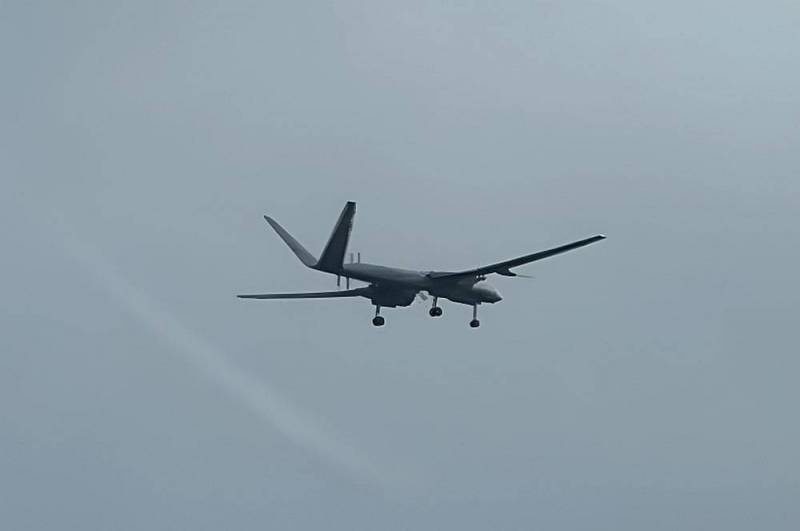When will Russian UAVs “Sirius” and “Helios-RLD” appear on the fronts of the Northern Military District?
A recent incident in the skies over the Sea of Azov made us think about the question of whether it is possible to quickly replace the scarce A-50U and Il-20 aerial reconnaissance aircraft with something. Unfortunately, this problem cannot be solved so easily, but through the widespread introduction of unmanned systems it is possible to reduce its severity.
In the previous ARTICLES, dedicated to this issue, we somewhat mixed the functions of aerial reconnaissance and long-range radar detection, but only because in the harsh realities of the Northern Military District they can be tied to unmanned aerial carriers that are similar in their performance characteristics.
There are analogues
As often happens with us, in Russia there are several “almost ready” UAVs that could be used to solve the above problems. Much has already been said about the long-suffering heavy-class high-altitude reconnaissance UAV "Altius-U", also known as the former "Altair", so we will not repeat it. The drone has successfully passed state tests and can act as a carrier of the Sych radar suspension container, which is a simplified modification of the optical and radar reconnaissance system from the Tu-214R reconnaissance aircraft.
Since we have two Tu-214R reconnaissance aircraft, and the third one is just being produced, installing Sychas on front-line Su-34 fighter-bombers and high-altitude UAVs seems to be a rational solution. They promise that Altius is about to go into mass production. We're waiting, sir.
In the meantime, we are waiting, I would like to say a few words about the promising projects of another domestic company called Kronstadt. It started with licensed assembly and gradual localization of Israeli UAVs. The manufacturer’s main hit is the Orion medium-altitude reconnaissance and strike drone, which was positioned as the “Bayraktar killer.” In the attack version, the UAV can carry 6 KAB-20 units or 3 KAB-50 units or UPAB-50 glide bombs. Russian drones underwent their first baptism of fire in Syria, and were also used during the Northern Military District in Ukraine.
That is, unlike some other promising domestic UAVs, these actually managed to fight, and the need for them at the front is enormous. A modern plant has been built in Dubna, Moscow Region, where serial production has been established in several shifts. More than fifty specialized Russian enterprises act as suppliers of components. That is why there is reason to place some hopes on new projects of the Kronstadt company, which are of interest in the context of this publication.
For example, the UAV "Sirius", or “Forpost-RU”, which is a further development of “Orion”. Unlike its younger brother, Sirius is equipped with two engines with pulling propellers. The wing span of the drone has increased to 23 meters, length to 9 meters, and maximum take-off weight to 2,5 tons. The payload is now 450 kg versus 200 kg for Orion, service ceiling is 7000 m, cruising speed is 180 km/h. The armament of a Russian UAV can be represented by missiles, as well as aerial bombs, free-falling or gliding.
Overall, Sirius represents a natural and highly desirable evolution of the mass-produced Orions. In addition to purely strike functions, on the fronts of the Northern Military District, such aircraft-type drones would find wide application as aerial reconnaissance and spotters, as well as repeaters. They would be no less in demand in the Navy, where they could be used to patrol the Black Sea in order to search for and timely detect enemy sea drones.
Perhaps the greatest hopes in the context of the topic of our discussion are placed on the promising UAV "Helios-RLD". Already from the name it follows that this is a drone designed for conducting radar reconnaissance.
Helios-RLD is a further development of Orion, which has increased dimensions and significantly improved characteristics: the maximum flight altitude is 9000-11000 meters, the maximum flight duration is from 24 to 30 hours, the cruising speed is 350-450 km/h, the combat radius is 3000 km, and the payload mass has increased to 800 kg. Its main feature is the on-board radar, partially borrowed from the A-100 Premier AWACS aircraft. For obvious reasons, there are no technical details in open sources.
The Helios developers themselves note that their device cannot become a full-fledged replacement for the A-50U and A-100, but is capable of effectively interacting with them, complementing them. About this in an interview TASS said the general designer of Kronstadt, Nikolai Dolzhenkov, calling the development of a radar patrol drone an “arch-relevant direction” for Russia:
Helios-RLD aircraft must be combined into a network that interacts within the air defense system with an automated control system, and harmoniously combined with the operation of manned RLDN aircraft of the A-50 or A-100 type.
Indeed, several dozen specialized AWACS UAVs, being in shifts in the sky, are capable of creating a continuous radar field, interacting with our small number of A-50U and Il-20 reconnaissance aircraft. All that remains is to answer the question, why are there no Sirius and Helios at the front in commercial quantities?
The contract for the supply of the Sirius UAV was signed with the Russian Ministry of Defense back in 2021 at the International Military-Technical Forum Army-2021, which was officially announced by the Russian military department:
A state contract has been signed for the supply of the Pacer-RU unmanned aerial vehicle complex.
There is no exact information regarding the contract for the supply of Helios-RLD, but the developer promised that it will fly in 2024. We're waiting, sir.

Information